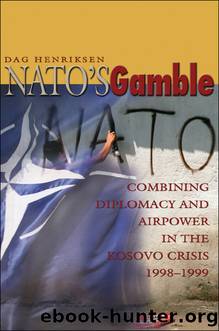NATO's Gamble by Dag Henriksen

Author:Dag Henriksen [Henriksen, Dag]
Language: eng
Format: epub
ISBN: 9781612515557
Publisher: Naval Institute Press
Map 4. Kosovo
The significance of this event should not be underestimated. The KLA had gained a martyr, and the deaths of the Jashari family left Kosovo reeling. As Tim Judah describes it, âYears of accumulated frustration boiled over and demonstrations were held across the province. Within weeks everything began to change, the status quo that had held since 1990 began to collapse and everyone was shocked by what was happeningâno one more so than the KLA men themselves.â According to Pleurat Sejdiu (of the KLA), the plan was to start a war in 1999 by bombing depots and such, but events in Albania (access to weapons) speeded things up. The killings of the Jashari family further accelerated the process, and in the Drenica Valley people began to say that now was the time to fight the Serbs. Across Drenica the Serb police began digging in and constructing fortified bunkers and checkpoints.25
With this incident the level of violence in Kosovo reached a critical threshold, one that demanded international attention. Unless stopped by a third party, the Serbs and the Kosovar Albanians were heading for war.
By now, though Ibrahim Rugova still argued for a nonviolent strategy, people seemed not to see the contradiction between supporting both Rugova and the KLAâarguing that the KLA was their army and Rugova their president. Still, as Veton Surroi argued, to define the KLA was hard, because it was still a somewhat splintered group of resistance fighters without one supreme commander giving orders. Some village groups just called themselves KLA because that was what everyone else was doing.26 Some were only fighting for Kosovo independence, while other KLA commanders made no secret that their ambition was to carve out a Greater Albania. In a conversation with Richard Holbrooke a KLA commander noted, âThis is the army which is liberating people,â adding, âour job is to free the whole of Kosovo, the Albanians of Macedonia and Montenegro too.â27
On 5 March, Gelbard reiterated the âChristmas warningâ to Belgrade, speaking so forcefully to MiloÅ¡eviÄ that the latter took a dislike to him and later refused to see him.28 The same day the NAC issued the first of many statements on the crisis, expressing its concern with the situation and urging Belgrade and the Kosovar Albanian community to find a political solution. Interestingly, it included a condemnation of âterrorist acts to achieve political goals.â29
The United States and NATO ruled out the use of force the first months of 1998, but, determined to use the lessons from Bosnia, Madeleine Albright took the lead to push the Europeans and the United States to act in concert. The first Contact Group meeting on the issue of Kosovo convened 9 March. Before the meeting, Secretary Albright stated in public, âWe are not going to stand by and watch the Serbian authorities do in Kosovo what they can no longer get away with in Bosnia.â30 President Clinton similarly noted, âWe do not want the Balkans to have more pictures like weâve seen in the last few days so reminiscent of what Bosnia endured.
Download
This site does not store any files on its server. We only index and link to content provided by other sites. Please contact the content providers to delete copyright contents if any and email us, we'll remove relevant links or contents immediately.
The Radium Girls by Kate Moore(11967)
100 Deadly Skills by Clint Emerson(4875)
Rise and Kill First by Ronen Bergman(4737)
The Templars by Dan Jones(4653)
The Doomsday Machine by Daniel Ellsberg(4446)
The Rape of Nanking by Iris Chang(4165)
Killing England by Bill O'Reilly(3968)
Hitler in Los Angeles by Steven J. Ross(3923)
Stalin by Stephen Kotkin(3916)
12 Strong by Doug Stanton(3525)
Hitler's Monsters by Eric Kurlander(3288)
Blood and Sand by Alex Von Tunzelmann(3164)
The Code Book by Simon Singh(3123)
Darkest Hour by Anthony McCarten(3095)
The Art of War Visualized by Jessica Hagy(2972)
Hitler's Flying Saucers: A Guide to German Flying Discs of the Second World War by Stevens Henry(2729)
Babylon's Ark by Lawrence Anthony(2644)
The Second World Wars by Victor Davis Hanson(2502)
Tobruk by Peter Fitzsimons(2475)
